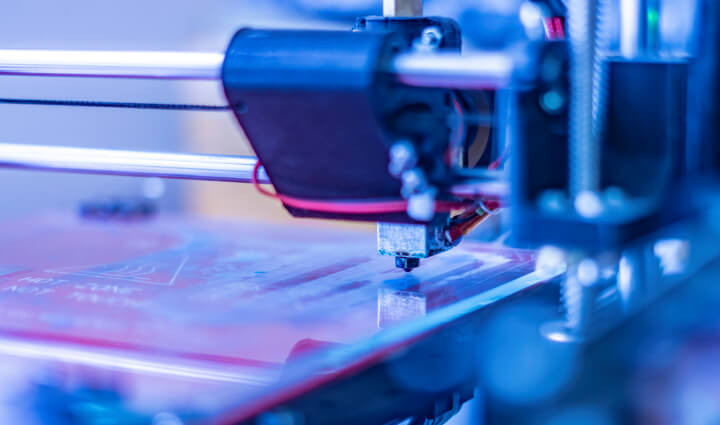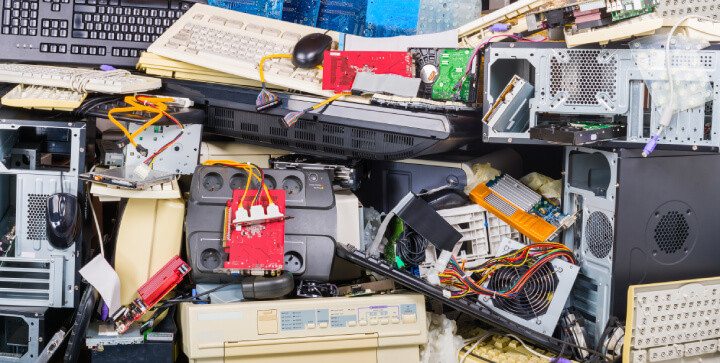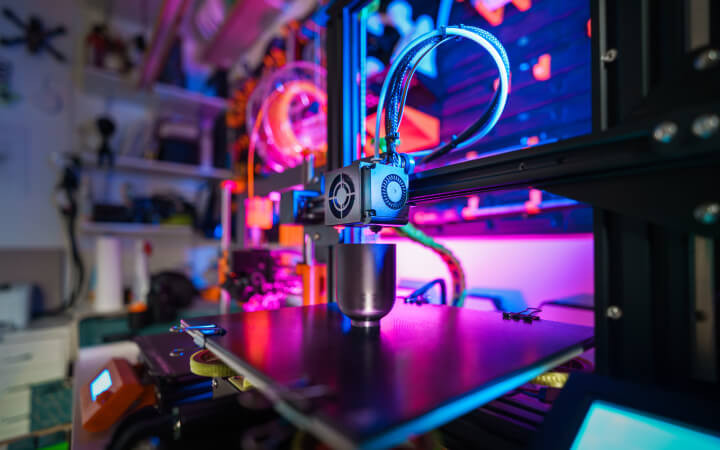The Rise of Microfactories: Is This the Future of Tech Manufacturing?
22-03-2024 | By Robin Mitchell

Key Things to Kow:
- Mass Production Evolution: The transition from through-hole to surface mount technology has significantly reduced the size and cost of electronics, enabling mass production and global distribution.
- Environmental and Ethical Concerns: The electronics industry faces challenges related to e-waste, environmental damage from raw material extraction, and ethical issues in manufacturing locations.
- Localised Manufacturing Potential: Emerging technologies like 3D printing could decentralise manufacturing, reducing environmental impact and fostering local economies.
- Technological Enablers: Advances in 3D printing, printed electronics, CNC machining, and laser engraving are key to realising the vision of microfactories and sustainable manufacturing practices.
The standard model of mass production and scale of operation has allowed electronics to become incredibly cheap and widely available, but as new manufacturing technologies such as 3D gain popularity, will manufacturing become more decentralised? What challenges is the electronics industry facing with regard to manufacturing and distribution? Could localised manufacturing become popular, and what technologies would empower such a future?
The Modern Challenges Faced By Electronics
Since the introduction of the electronics industry, it has been well established that in order for electronics to be affordable and accessible, it needs to become as small as possible and manufactured at scale. The first components, being through-hole, required thousands of expert production line workers to feed components through PCBs, solder the legs, and remove excess component leads, and this production method made mass-scale manufacturing difficult.
When surface mount technology came along, the size of PCBs rapidly shrunk, which not only made them cheaper to produce, but allowed for more complex designs. But it was the introduction of pick and place that really allowed electronics to become far more accessible.
Finally, the large-scale nature of pick and place and surface mount parts combined with industrial standardisation and the use of common components has resulted in an industry that can rapidly expand, quickly scale, and reach markets across the entire planet. For perspective, entire reels of capacitors and resistors containing thousands of components can be bought for dollars, many microcontrollers are now in the cent range, and the widespread use of SoCs is allowing for designs to be immensely complex while remaining extremely small in size.
The Double-Edged Sword of Mass Production in Electronics
But for all the advantages that mass production in electronics has provided, there are a number of issues that continue to plague the industry. The large-scale nature of electronics manufacturing and the obscenely low cost of components has encouraged a throw-away society, resulting in perfectly usable devices finding their way into landfills.
This global production of e-waste is not only economically wasteful but is also contributing to serious environmental damage. Despite modern components rarely containing harmful compounds (such as lead and cadmium), there is an enormous amount of e-waste from the past and present that does, and when this waste is improperly disposed of (either through landfill burial or incineration), these compounds are released into the environment, which can pollute the air and groundwater sources.
The large-scale consumption of electronics is also introducing challenges with regard to CO2 production and environmental damage through raw-material mining. Simply put, in order for electronics to stay cheap, they have to be produced in the millions, and this requires large amounts of materials to be sourced, mined, and processed.
Considering that many of these mines are found in developing nations, there is often little care for the environment, which often leads to long-lasting damage to local areas. As these minerals will often be processed where they are mined, the use of environmentally damaging processes further damages both the local environment and the climate in general.
Bridging the Gap: From Environmental Impact to Recycling Challenges
One potential solution is to recycle electronics, but this is far easier said than done. To start, trying to scrap circuits for parts can be difficult if they are built from SMD parts due to their extremely small size and the fact that new SMD parts are extremely cheap (thus making component salvaging uneconomical). Secondly, as circuits often require a degree of reliability, the fact that used components cannot provide the same guarantees that new parts can means that they are simply not suitable for new designs.
Extracting precious metals from PCBs is possible, but as it involves the use of extremely corrosive compounds, those recycling PCBs need to exercise the utmost caution. Such processes also require a large amount of manual labour, separating components from the board, isolating parts with precious metals, and the numerous chemical steps involved. Thus, extracting precious metals is only economical when done at scale.

From Recycling Hurdles to Security Concerns: Navigating the Complex Landscape
Another challenge faced with modern electronics is that as many devices are often made in the Far East, security and privacy in such devices can be hard to guarantee. For example, millions of smart home IoT devices are produced by Chinese manufacturers a year, and the low-cost nature of these devices makes them highly desirable, especially in the current cost-of-living crises.
However, it is likely that these devices either carry backdoor access, or have hidden hardware/software to perform remote attacks (something which the Chinese Communist Party is well known to be involved in). Furthermore, the data gathered by these devices is likely stored on Chinese servers, which the Chinese government undoubtedly has access to (something which the Chinese government introduced by law).
To summarise all of this, the electronics industry has massively benefited from large-scale production techniques, but in doing so, the environment continues to struggle, electronic devices are not easy to recycle, and large amounts of manufacturing are done in faraway places that may not have the best works rights, poor manufacturing practices, and violating consumer rights.
Could localised manufacturing be the solution?
When looking at how market forces and industrial processes work, it can be hard to imagine any other manufacturing topology than the one that currently dominates the world; mass-scale production at large facilities. However, the emergence of new technologies such as 3D printing may soon change all of this, essentially making manufacturing a decentralised process.
The idea behind local miniaturised manufacturing is that instead of having all products produced at a factory and then shipped all over the world, devices are made where needed, utilising technologies that can easily produce parts on an individual scale (as opposed to a large scale). Such a site would also be ideal for e-waste recycling, where devices can be traded in, salvaged, and sustainably turned into raw materials that can go on to be used in other products.
Envisioning a Sustainable Future: The Role of Localised Manufacturing and Recycling
For example, old phone cases made from recycled plastics could be ground down and turned into filament that can then be used to make new cases. The same can be done for smartphones, whereby key components can be extracted (processor, memory, and screen), and the rest of the device properly recycled.
Of course, such a microfactory would require a fundamental change in how engineers develop products. Instead of relying on complex, unique designs, devices would have to be constructed from commonly used parts that can easily be fitted together. In the case of smartphones, future devices would have to use a singular connector that would work for all screen sizes (similar to a micro HDMI) and a common architecture in the motherboard.
Such microfactories would also help to empower local areas, especially those that are remote. Instead of needing to ship devices from thousands of miles away, it could be possible to have a product built from scratch. As recycled materials would be kept local to the micro-factory, the environmental impact from consumption would be minimal, all while providing the exact services needed by locals.
What technologies could empower such a future?
With the current state of technology, the idea of a microfactory is more of a dream than a reality, but that isn’t to say that the concept is far from being realised.
The most prominent technology for empowering such a future is 3D printing, and this is due to its ability to produce any shape without the need for moulds or complex heavy machinery. As 3D printing can be used with a wide range of recycled materials, it is ideal for use at a local recycling centre, grinding down old materials and turning them into pellets and/or filaments.

Furthermore, because 3D printers can print multiple materials simultaneously, they can be used to create complex designs, with components directly printed into the inner parts of a case (such as an antenna).
Advancements in 3D Printing and Printed Electronics: Pioneering the Future of Microfactories
Another major technology that will benefit microfactories is printed electronics. Similar to 3D printers, printed electronics are circuits that can be made entirely from traditional printing technologies (such as inkjet printers). Unlike 3D printers, printed electronics can have extremely small details, which makes it ideal for printing passive components on complex designs. However, work is being done to produce semiconductors using the same process, meaning that it could become possible to create functional circuits, all from printable inks.
CNCs are another production method that will help realise microfactories, and while these machines have existed for decades, it is only recently that they have become extremely affordable. Instead of paying thousands of dollars for a single unit, it will become possible to have many smaller machines that can all work on individual projects simultaneously.
Even laser engraves are becoming cheaper, which themselves are extremely useful for manufacturing. However, unlike CNCs using mechanical milling bits, laser cutters are far easier to automate, can produce parts far quicker, and perfect for small to medium scale production runs.
While these are not all the technologies that will help empower microfactories, they demonstrate that small-scale manufacturing is perfectly possible and could very well become a desired topology for future engineers.

